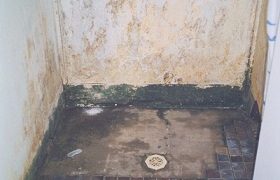Home > News & Media > News > Waterproofing correctly can save the builder and home owner $
Waterproofing correctly can save the builder and home owner $
It is a known fact that water damage to buildings represents one of the major costs to builders and home owners.
Protecting a home from water damage involves many factors.
Ranging from simple things like sealing or replacement of old silicone around shower cubicles, window flashings & gutters, considering placing weather strips on doors can all assist, or considering the waterproofing at architectural design stage when building a home.
When it comes to the internal wet areas, quite often the cost of waterproofing additional areas leads to builders only doing the basic wet area, such as the shower section and possibly floor to wall flashing.
The real cost of waterproofing to best waterproofing practice is far more economical then carrying out rectification works. For instance, due to waterproofing not being done correctly, where water has saturated the timber frame causing rot or caused mould/fungi/mildew due to the dampness behind tiles or fittings that can leave the areas with foul smells and also risk causing the occupant’s in the home health problems, especially if a member of the family have asthma or breathing issues.
Therefore, the best practice & most economical method to use when waterproofing wet areas, is to remember that it is best to waterproof the entire wet area including using a water stop at the wet area entry points.
When the full wet area is waterproofed using a water stop at the entry point, a vessel is created. This has the advantage of keeping water from entering the building structure beyond this area.
The next important point is to have good fall to waste outlets in the room, as this ensures water within the wet area, can safely drain and not build up allowing water to escape the room.
Finally, tiling directly onto a membrane will also reduce area for water to build up.
To ensure you use the best waterproofing for your builds make sure yo understand the best waterproofing practice methods. Wet-seal expert waterproofers can assist you in planning around waterproofing to ensure the best job is done on every build.
For any other advice of a technical nature, Wet-seal’s highly experienced technical expert, Robert Rath, will be happy to take your call. Robert can be contacted on 0800 436 000 or via email rrath@wet-seal.ws
Alternatively, please speak with your local Franchisee directly. Details of how to contact your local Franchisee can be found at Find A Franchisee
Wet Areas & Mould
When waterproofing a wet area, it is worthwhile considering how best to create a safe environment for the occupants. Many homes within Australia use a mortar based screeded bed to achieve falls to the drainage outlets & have the waterproofing under the screed, especially within the shower area.
Water doesn’t take long to find a hairline crack from thermal movement or building movement within the tiled wet area grout and seep into a dry mortar-based screed below the tiling.
This itself is not such an issue, as mortar-based screeded tile beds, still are fit for purpose if they are wet or dry.
Australian Standards AS3740-2010 amendment 2012 for internal wet areas, deals with water seepage through the grout and screeded tile bed.
It is important to note that a drainage flange is compulsory in all wet areas
(not a riser cut off), the waterproof membrane terminates into the drainage flange. The advantage of the drainage flange allows the natural air flow over the waste outlet creating a wicking effect of the screeded bed, thus drawing the moisture out of the tile screeded bed and reducing the tile screeded bed saturation.
Waterproofing on top of a screed bed, with direct sticking the tiles, will minimise the risk of fungi/mould in the screed bed while still maintaining a fit for purpose wet area.



